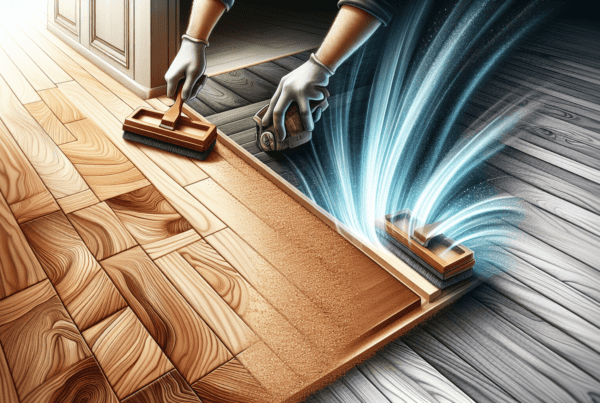If you’ve ever looked at your wooden floors and longed for a way to bring them back to their original glory, then you’re in luck. In Wellington, the art of timber floor sanding and finishing is something that’s not only widely appreciated but also highly accessible. This guide will offer an insightful exploration into how this transformative process can breathe new life into your floors, enhancing their beauty, durability, and overall value. Let us take you on a journey through the meticulous steps of sanding and finishing, ensuring your timber floors look as splendid as the day they were laid down.
Understanding Timber Floor Sanding
Definition and Benefits
Timber floor sanding is a process we undertake to revitalize our wooden floors, making them look fresh and new. It involves the removal of the top surfaces of a wooden floor by sanding with abrasive materials. The benefits we’ve discovered are numerous: it not only enhances the floor’s appearance but also increases its longevity, removes scratches and dents, and prepares the surface for finishing. Sanding makes our floors easier to clean and maintain, creating a healthier environment by reducing allergens.
The Process of Floor Sanding
The process of floor sanding is quite meticulous and involves several steps to ensure a smooth, flawless finish. Initially, it begins with assessing the condition of the floor to determine the appropriate grit of sandpaper to use. Following this, the actual sanding takes place, starting with coarse-grit sandpaper and progressively moving to finer grits. This gradual progression helps to effectively remove the old finish and smoothens the wood.
Types of Timber Floors Suitable for Sanding
Virtually all types of timber floors can be sanded, from solid hardwood floors to engineered wood floors. However, the suitability can depend on the thickness of the wood, especially for engineered floors, as the top wood layer must be thick enough to withstand the sanding process without damage.
Preparation Steps Before Sanding
Before we embark on the sanding journey, it’s imperative to prepare the floor properly. This involves removing all furniture and fittings from the room, repairing any damaged floorboards, and ensuring the floor is clean and free from any nails or staples that might damage the sanding equipment.
Choosing the Right Equipment for Floor Sanding
Types of Sanders Used for Timber Floors
There are various sanders available for timber floor sanding, including drum sanders, orbital sanders, and edge sanders. Each serves a particular purpose – drum sanders for the main floor area, orbital sanders for fine sanding, and edge sanders for the corners and edges.
Safety Equipment Needed
Safety cannot be overstressed when it comes to floor sanding. We always ensure we have dust masks, safety goggles, and ear protection. This not only protects our health but also makes the sanding process more comfortable.
Selecting the Right Sandpaper Grit
The selection of sandpaper grit is crucial. We start with a coarser grit to remove the old finish and imperfections and gradually move to a finer grit for a smooth finish. The exact grits used can vary based on the floor’s condition and the desired finish quality.
Rental vs. Professional Equipment
For those of us tempted to embark on a DIY floor sanding project, renting equipment is an option. However, the quality of rental equipment can vary, and without experience, it’s easy to make mistakes. Alternatively, professional equipment handled by experienced individuals can ensure a high-quality finish and save considerable time and effort.
The Step-by-Step Process of Timber Floor Sanding
Preparing the Area
Preparing the area properly is key to a successful sanding project. This means removing all furniture, ensuring the floor is clean, and securing loose boards.
Coarse Sanding Stage
In the coarse sanding stage, we use low-grit sandpaper to remove the old finish and level the floor. It’s the most aggressive sanding stage, designed to strip down imperfections.
Medium Sanding Stage
Following the coarse sanding, we switch to a medium grit sandpaper to start smoothing out the floor. This step further refines the surface, preparing it for the final sanding stage.
Fine Sanding for a Smooth Finish
The fine sanding stage uses high grit sandpaper for a smooth finish. It’s essential for achieving the polished look we all desire, preparing the floor for the finishing touches.
Cleaning Up After Sanding
Once the sanding is completed, we embark on a thorough cleanup. This involves vacuuming the dust and wiping the floor with a damp cloth to remove any residual dust, ensuring a clean surface for finishing.
Common Mistakes to Avoid in Floor Sanding
Not Preparing the Surface Properly
One of the most common mistakes is failing to prepare the surface properly. This can lead to uneven sanding and damage to the floor.
Skipping Grits
Skipping grits can leave scratches from coarser grits that are difficult to remove later. It’s crucial to progress gradually from coarse to fine grits.
Sanding Too Aggressively
Sanding too aggressively can lead to gouges and uneven surfaces. Gentle and even pressure is key.
Ignoring Safety Precautions
Ignoring safety precautions can lead to health risks from dust inhalation and hearing damage. Always use the appropriate safety equipment.
Options for Timber Floor Finishing
Types of Finishes Available
There’s a variety of finishes available, from polyurethanes to oils and waxes. Each offers a different aesthetic and level of protection.
Choosing the Right Finish for Your Floor
The choice of finish depends on the usage of the room, desired aesthetic, and maintenance level. We always consider these factors carefully to select the best finish for our floors.
The Role of Stain in Floor Finishing
Stain can be applied before the final finish to alter the color of the wood. It allows us to customize the look of our floors to match our desired aesthetic.
Pros and Cons of Different Finish Types
Each finish type has its pros and cons. Polyurethanes are durable and low maintenance but can be difficult to repair. Oils and waxes offer a natural look and are easier to repair but require more frequent maintenance.
Applying the Finish: Techniques and Tips
Preparing the Floor for Finishing
Preparation for finishing involves ensuring the floor is perfectly clean and free from dust. Sometimes, a final fine sanding with a very high grit sandpaper is necessary.
Application Methods for Various Finishes
The application methods vary depending on the type of finish, from brushing to rolling or even spraying. Following the manufacturer’s instructions is crucial for a successful application.
Achieving a Professional Look
Achieving a professional look involves careful application, maintaining a wet edge to avoid lap marks, and applying the correct number of coats as recommended by the manufacturer.
Drying Times and Ventilation Requirements
Drying times can vary significantly between finishes. Adequate ventilation is crucial to ensure the finish dries properly and to avoid inhaling fumes.
Maintenance Tips for Sanding & Finished Floors
Regular Cleaning Guidelines
Regular cleaning with a soft broom or vacuum and occasional damp mopping with a suitable cleaner helps maintain the floor’s appearance and longevity.
Spot Repair Tips
For minor damages, spot repair kits are available that can blend well with the existing finish.
Preventing Scratches and Dents
Using furniture pads, avoiding dragging furniture, and keeping pets’ nails trimmed can help prevent scratches and dents.
Refinishing Interval Recommendations
The interval for refinishing depends on the wear and tear but generally ranges from every 5 to 10 years to keep the floors looking their best.
Cost Considerations for Timber Floor Sanding & Finishing
Estimating Your Project Budget
The cost can vary widely based on the floor’s condition, the area’s size, and the chosen finish type. Getting multiple quotes can help estimate the project budget more accurately.
Costs of DIY vs. Hiring Professionals
DIY can be more cost-effective but risky if we’re not experienced. Hiring professionals ensures a high-quality finish but at a higher cost.
Factors Influencing the Total Cost
Factors that can influence the cost include the level of floor damage, the cost of the chosen finish, and any required repairs.
Budgeting for Maintenance
Setting aside a budget for regular maintenance helps prolong the floor’s life and maintain its appearance, saving money in the long run.
Selecting a Professional Service in Wellington
Tips for Finding Reliable Services
Researching online, asking for recommendations, and checking reviews can help us find reliable floor sanding and finishing services in Wellington.
Important Questions to Ask Before Hiring
Inquiring about their experience, insurance, the equipment used, and getting a detailed quote can help ensure we select the right professionals for our project.
Understanding Quotes and Services Offered
Carefully reviewing the quotes and understanding what services are included helps avoid unexpected costs and ensures the project meets our expectations.
Reviews and Recommendations
Reading reviews and asking for recommendations provides insights into the quality of service and customer satisfaction, aiding in making an informed decision.
Environmental Considerations and Sustainable Practices
Choosing Eco-Friendly Finishes
Opting for eco-friendly finishes made from natural oils and waxes can reduce environmental impact and improve indoor air quality.
Sustainability in Timber Flooring Choices
Selecting sustainably sourced or reclaimed timber floors is another way we contribute to environmental conservation.
Recycling and Disposing of Sanding Waste
Properly recycling or disposing of sanding waste and old finish materials minimizes environmental harm.
Energy Efficiency and Indoor Air Quality
Ensuring adequate ventilation during the sanding and finishing process not only improves energy efficiency but also maintains healthy indoor air quality.
Through understanding and attention to detail in every stage of timber floor sanding and finishing, we can transform our floors into beautiful, durable surfaces that enhance our homes in Wellington. By choosing the right professionals, finishes, and maintenance practices, we ensure our floors remain a valuable and cherished part of our homes for years to come.







